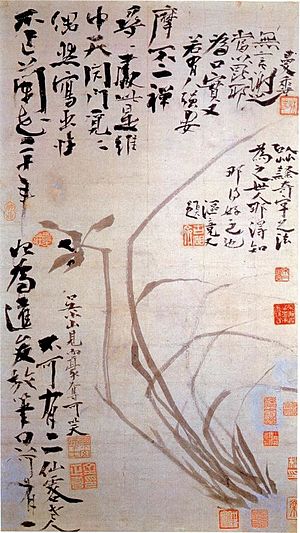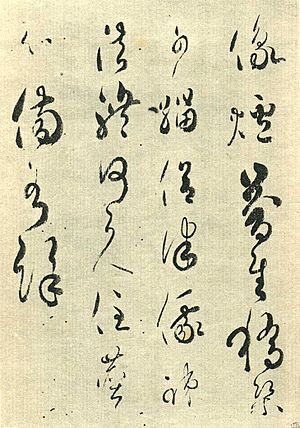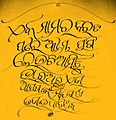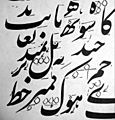East Asian calligraphy facts for kids
Quick facts for kids East Asian calligraphy |
|||||||
|---|---|---|---|---|---|---|---|

The traditional Chinese character for "writing" or "book".
|
|||||||
| Chinese name | |||||||
| Traditional Chinese | 書法 | ||||||
| Simplified Chinese | 书法 | ||||||
|
|||||||
| Vietnamese name | |||||||
| Vietnamese | Thư Pháp | ||||||
| Hán-Nôm | 書法 | ||||||
| Korean name | |||||||
| Hangul | 서예 | ||||||
| Hanja | 書藝 | ||||||
|
|||||||
| Japanese name | |||||||
| Kanji | 書道 | ||||||
| Hiragana | しょどう (modern) しよだう (historical) |
||||||
|
|||||||
East Asian calligraphy is a beautiful way of writing that started and grew in China. It's an art form where words are written with special brushes and ink. This amazing tradition is practiced in countries like China, Japan, Korea, and Vietnam.
Contents
What Tools Do Calligraphers Use?
To create beautiful calligraphy, artists use several special tools. These include paper, ink, a brush, an ink stone, a paperweight, and a desk pad. Each tool plays an important part in making the artwork.
Special Paper for Calligraphy
The paper used for calligraphy is very unique. It is often made from materials like rice, paper mulberries, bamboo, or hemp. This special paper helps the ink flow smoothly and absorb just right.
How Is Calligraphy Ink Made?
Traditional calligraphy ink is made from soot and special binders. It usually comes in solid sticks. To use it, you rub the ink stick with water on an ink stone. This creates liquid ink. Today, you can also buy pre-mixed bottled inks, which are great for practicing.
The Calligraphy Brush
The brush is one of the most important tools. The handle of the brush can be made from bamboo. Sometimes, rare materials like red sandalwood, glass, ivory, silver, or gold are used for fancy brushes. The brush head is made from animal hair. Common types include hair from wolf, rabbit, deer, chicken, duck, goat, pig, and tiger.
What Is an Ink Stone For?
An ink stone is a special flat stone. Its main job is to help turn the solid ink stick into liquid ink. You add a little water to the stone and then grind the ink stick on it. This creates the perfect ink for writing.
Why Use a Paperweight?
Paperweights are used to hold the paper still while you write. This stops the paper from moving around. Many paperweights are not just useful tools; they are also beautiful works of art that people collect.
The Calligraphy Desk Pad
A desk pad is a soft pad, often made of felt. Students often use desk pads that have grids printed on both sides. When you place the paper on top of the pad, the grid underneath helps you make your words the right size and put them in the correct place on the page.
Famous Calligraphers
For a long time, many educated men (and some women) in East Asia learned calligraphy. It was an important skill. Here are some of the most famous calligraphers from different countries:
China's Master Calligraphers
- Mi Fei
- Wei Shuo
- Wang Xizhi
- Wang Xianzhi
- Huai Su
- Qigong
- Yu Shinan
- Zhang Xu
- Yan Zhenqing
- Liu Gongquan
- Ouyang Xun
- Su Shi
- Huang Tingjian
- Emperor Huizong of Song Dynasty
- Zhao Mengfu
- Liu Bingsen
- Mao Zedong
- Chiang Kai-Shek
- Kang Youwei
- Zheng Banqiao
- Huang Ruheng
- Shi Kefa
You can find more information about Chinese calligraphy history here.
Japanese Calligraphy Artists
- Kūkai
- Emperor Saga
- Tachibana no Hayanari
- Ono Michikaze
- Fujiwara no Sukemasa
- Fujiwara no Yukinari
- Hon'ami Kōetsu
- Konoe Nobutada
- Shokado Shojo
- Ryōkan
- Yamaoka Tesshu
- Igaki Hokujo
Korean Calligraphy Masters

- Choi Chiwon
- Kim Saeng
- Tan Yeon
- Yi Aam
- Yi Yong
- Bak Jega
- Kim Jeonghee
- Kim Myeong-hui
- Han Seokbong
- Sejong the Great
- Grand Prince Anpyeong
- Kang Sehwang
- Yun Sun
- Yi I
- Yi Hwang
- Yi Sun-sin
- Shin Saimdang
- Jeong Yak-yong
- Kim Okgyun
Different Calligraphy Styles
Calligraphy has many different writing styles, each with its own look and feel. Here are some of the main ones:
- Seal Script (also called small seal script) is one of the oldest styles.
- Clerical Script (sometimes called official or scribal script) was used for official documents.
- Semi-cursive Script (also known as running script) is a faster, more flowing style than regular script.
- Cursive Script (sometimes called grass script) is a very quick and expressive style, often hard to read for beginners.
- Regular Script (often called 'standard script') is a clear and neat style, commonly taught to students.
- Edomoji is a style of Japanese calligraphy used for signs and advertisements.
- Munjado is a Korean style that combines characters with pictures.
- Kao is a personalized signature or monogram used by Japanese calligraphers.
Images for kids
-
On Calligraphy by Mi Fu, Song Dynasty
-
Japanese calligraphy: the word "peace" and the signature of the Meiji-period calligrapher Ōura Kanetake, 1910
-
A painting of Susenyos I (r. 1607–1632) on a Ge'ez prayer scroll meant to dispel evil spirits, Wellcome Collection, London
-
Მარიამისეული ქართლის ცხოვრება.JPG
The Georgian calligraphy is centuries-old tradition of an artistic writing of the Georgian language with its three scripts.
-
Bowl with Kufic Calligraphy, 10th century. Brooklyn Museum.
-
A Bön text
-
Folio 27r from the Lindisfarne Gospels (c.700) contains the incipit from the Gospel of Matthew.British Library, London.
-
Calligraphy in a Latin Bible of 1407 on display in Malmesbury Abbey, Wiltshire, England. This Bible was hand-written in Belgium, by Gerard Brils, for reading aloud in a monastery.
















